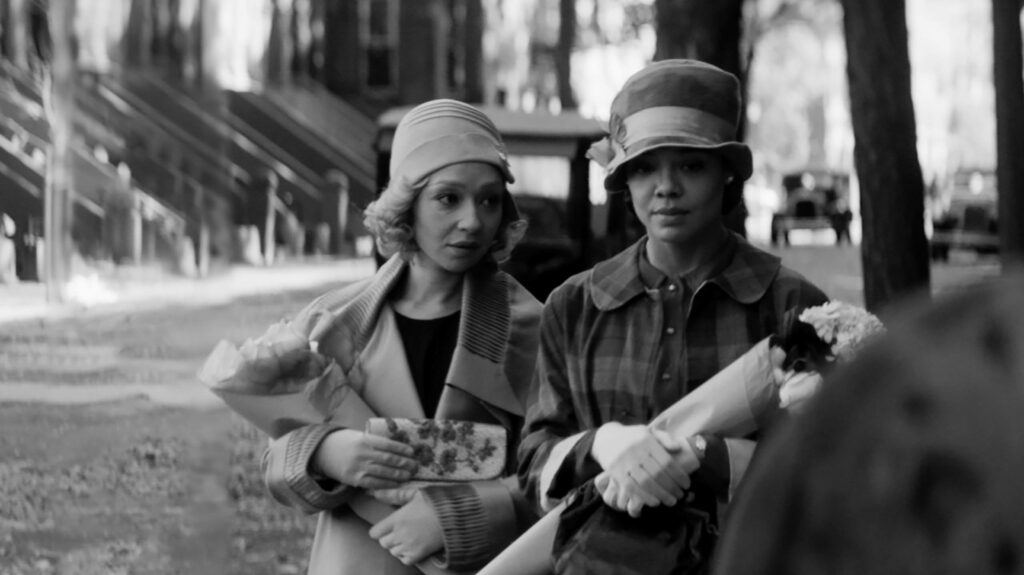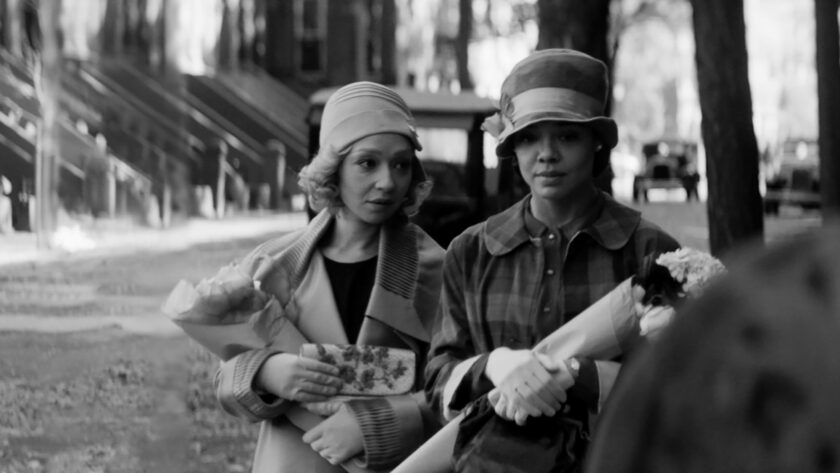Ellie Lachs reviews Rebecca Hall’s dramatic directorial debut exploring the practice of ‘passing’ and the questions it raises about racial identities.
Based on Nella Larson’s 1926 novel, Rebecca Hall’s directorial debut Passing offers an intricate and alluring observation of New York’s racialised landscape. The film is centred around two childhood friends who, after drifting apart, are thrown back together by a coincidental meeting in town. In this moment of reconciliation, Claire (Ruth Negga) presents as a seductively elegant figure who, after marrying a white man, has spent her life “passing” as white in spite of her mixed-race heritage in a world orbiting around New York’s ‘socialites’. Irene (Tessa Thompson) on the other hand has built herself a life which largely rejects Claire’s. Irene too could ‘pass’ if she wanted to, and yet she does not: “Why would I?”
Despite the awkwardness of this opening scene, and Irene and Claire’s inability to see eye to eye on the matter of ‘passing’, their lives quickly become intertwined as Claire becomes persistent in trying to repair their friendship. She “dream[s] [of coming] back… to that other life that [she] thought [she] was so happy to be rid of ”, and after some time (and moments of truculence) Irene eventually yields. She takes Claire to the community events that she organises in Harlem, invites her over for dinners and begins to include her in her day-to-day life. It doesn’t take Claire long to re-insert herself into the community that she left, and she does so with irresistible vivacity and charm. However, where Claire dominates and saturates the spaces that she is afforded, she becomes somewhat parasitic to Irene. Their relationship begins to fracture at the point where their values and morals conflict, and though these cracks are painted over with moments of infatuation and awe, a sense of struggle commences, albeit silent, passive, and suppressed.
Thompson and Negga’s performances are astonishing. Negga effortlessly embodies a character that, with her fluttering eyes, softly-spoken words, and enchanting charisma, is posited somewhere between the 1920s ingenue and flapper girl. She remains perfectly composed, and spears on ahead with unapologetic conviction; Claire does not see her position as tragic, as an audience member might. Thompson, on the other hand, gives us a more intense, emotive performance. Her character is rife with internal conflict, and Thompson nourishes and feeds this pressure and tightness whilst somehow still managing to retain a facade of self control. Through a web of perfectly composed smiles, wit, and wisdom, Thompson’s ability to capture this acute sense of tension is unparalleled.

As the film goes on, there is a complete shift in tone as Claire slowly begins to implode. The rich sense of empathy that opened the film disintegrates. Character interactions become decidedly light touch and uninterested, and the whole film migrates into the most volatile and unattractive parts of Claire’s mind. Where the film began in the sweltering heat, it descends into the harsh cold.
From the more technical side of things, Passing is beautifully shot and delicately sequenced, courtesy of cinematographer, Eduard Grau. Utilising a 4:3 aspect ratio, each scene feels like a perfect, portrait-like moment; facial expressions, body postures and subtle movements of the hand, the eyebrow, or the neck tell more of this story than any dialogue can. So much of the film meddles with quietness, and yet the silence pales in the light of the actors’ subtle and remarkable ability to enrich their actions with such intensity. Of course, its being in black and white is one of the film’s greatest strengths, visually laying the precedent for racial ambiguity and circumventing any distractions from the topic; it is a streamlining feature and comes as a refreshing halt to the often overstimulated, over-coloured and over-embellished film that we so often see. Hall strips cinema right back to its bones, allowing herself to examine her subject from a far more incisive standpoint.
However, this homage to 1920s film does bring with it some downsides. The film is largely mapped out by musical motifs, and moments of repetition supposed to represent Irene’s fragile mental state and sense of self-affliction; yet, these insertions feel a little heavy handed. The repeated chiming of clocks feels jarring and is in many ways more disruptive than informative. In these moments, Hall’s quirky and arty attempts feel more affectatious than necessary, and whilst she does display a level of ambition and artistic license here, the story that she is trying to tell does not need this sort of embellishment. However, as Hall put it herself, ‘it is a film with many questions at its core; is it about race, sexuality, mental health, femininity?’ And these questiones are raised with such nuance and subtlety they do largely compensates for its more contrived cinematographic moments.
Passing‘s concourse of themes are so subtly and intricately interwoven, they leave you at a loss for words. It is not a film that tries to distill or define one idea or one set of politics for the sake of audience satisfaction or moralising effect, instead merely laying out a huge array of tools and nails which can, for lack of a better word, be assembled in any manner of ways. It is up to the audience to decide which form of flatpack furniture they wish to, or need to, make out of it. It is not often that a film feels so utterly complete and unresolved at the same time.




